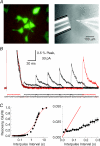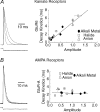Ion-dependent gating of kainate receptors
- PMID: 19822544
- PMCID: PMC2821548
- DOI: 10.1113/jphysiol.2009.178863
Ion-dependent gating of kainate receptors
Abstract
Ligand-gated ion channels are an important class of signalling protein that depend on small chemical neurotransmitters such as acetylcholine, l-glutamate, glycine and gamma-aminobutyrate for activation. Although numerous in number, neurotransmitter substances have always been thought to drive the receptor complex into the open state in much the same way and not rely substantially on other factors. However, recent work on kainate-type (KAR) ionotropic glutamate receptors (iGluRs) has identified an exception to this rule. Here, the activation process fails to occur unless external monovalent anions and cations are present. This absolute requirement of ions singles out KARs from all other ligand-gated ion channels, including closely related AMPA- and NMDA-type iGluR family members. The uniqueness of ion-dependent gating has earmarked this feature of KARs as a putative target for the development of selective ligands; a prospect all the more compelling with the recent elucidation of distinct anion and cation binding pockets. Despite these advances, much remains to be resolved. For example, it is still not clear how ion effects on KARs impacts glutamatergic transmission. I conclude by speculating that further analysis of ion-dependent gating may provide clues into how functionally diverse iGluRs families emerged by evolution. Consequently, ion-dependent gating of KARs looks set to continue to be a subject of topical inquiry well into the future.
Figures








Similar articles
-
External ions are coactivators of kainate receptors.J Neurosci. 2006 May 24;26(21):5750-5. doi: 10.1523/JNEUROSCI.0301-06.2006. J Neurosci. 2006. PMID: 16723532 Free PMC article.
-
Defining the structural relationship between kainate-receptor deactivation and desensitization.Nat Struct Mol Biol. 2013 Sep;20(9):1054-61. doi: 10.1038/nsmb.2654. Epub 2013 Aug 18. Nat Struct Mol Biol. 2013. PMID: 23955023 Free PMC article.
-
Cations but not anions regulate the responsiveness of kainate receptors.J Neurosci. 2011 Feb 9;31(6):2136-44. doi: 10.1523/JNEUROSCI.4314-10.2011. J Neurosci. 2011. PMID: 21307250 Free PMC article.
-
Structure and symmetry inform gating principles of ionotropic glutamate receptors.Neuropharmacology. 2017 Jan;112(Pt A):11-15. doi: 10.1016/j.neuropharm.2016.08.034. Epub 2016 Sep 20. Neuropharmacology. 2017. PMID: 27663701 Free PMC article. Review.
-
Gating and permeation of kainate receptors: differences unveiled.Trends Pharmacol Sci. 2010 Nov;31(11):516-22. doi: 10.1016/j.tips.2010.08.004. Epub 2010 Sep 16. Trends Pharmacol Sci. 2010. PMID: 20850188 Review.
Cited by
-
Conformational flexibility of the ligand-binding domain dimer in kainate receptor gating and desensitization.J Neurosci. 2011 Feb 23;31(8):2916-24. doi: 10.1523/JNEUROSCI.4771-10.2011. J Neurosci. 2011. PMID: 21414913 Free PMC article.
-
The multifaceted subunit interfaces of ionotropic glutamate receptors.J Physiol. 2015 Jan 1;593(1):73-81. doi: 10.1113/jphysiol.2014.273409. Epub 2014 Jul 10. J Physiol. 2015. PMID: 25556789 Free PMC article. Review.
-
Retour aux sources: defining the structural basis of glutamate receptor activation.J Physiol. 2015 Jan 1;593(1):97-110. doi: 10.1113/jphysiol.2014.277921. Epub 2014 Oct 21. J Physiol. 2015. PMID: 25556791 Free PMC article. Review.
-
Zinc potentiates GluK3 glutamate receptor function by stabilizing the ligand binding domain dimer interface.Neuron. 2012 Nov 8;76(3):565-78. doi: 10.1016/j.neuron.2012.08.027. Neuron. 2012. PMID: 23141068 Free PMC article.
-
Structural basis of GluK2 kainate receptor activation by a partial agonist.Nat Struct Mol Biol. 2025 Aug;32(8):1456-1469. doi: 10.1038/s41594-025-01566-w. Epub 2025 May 29. Nat Struct Mol Biol. 2025. PMID: 40442317
References
-
- Aldrich RW, Corey DP, Stevens CF. A reinterpretation of mammalian sodium channel gating based on single channel recording. Nature. 1983;306:436–441. - PubMed
-
- Antonov SM, Gmiro VE, Johnson JW. Binding sites for permeant ions in the channel of NMDA receptors and their effects on channel block. Nat Neurosci. 1998;1:451–461. - PubMed
-
- Armstrong N, Gouaux E. Mechanisms for activation and antagonism of an AMPA-sensitive glutamate receptor: crystal structures of the GluR2 ligand binding core. Neuron. 2000;28:165–181. - PubMed
Publication types
MeSH terms
Substances
LinkOut - more resources
Full Text Sources
Molecular Biology Databases
Miscellaneous

